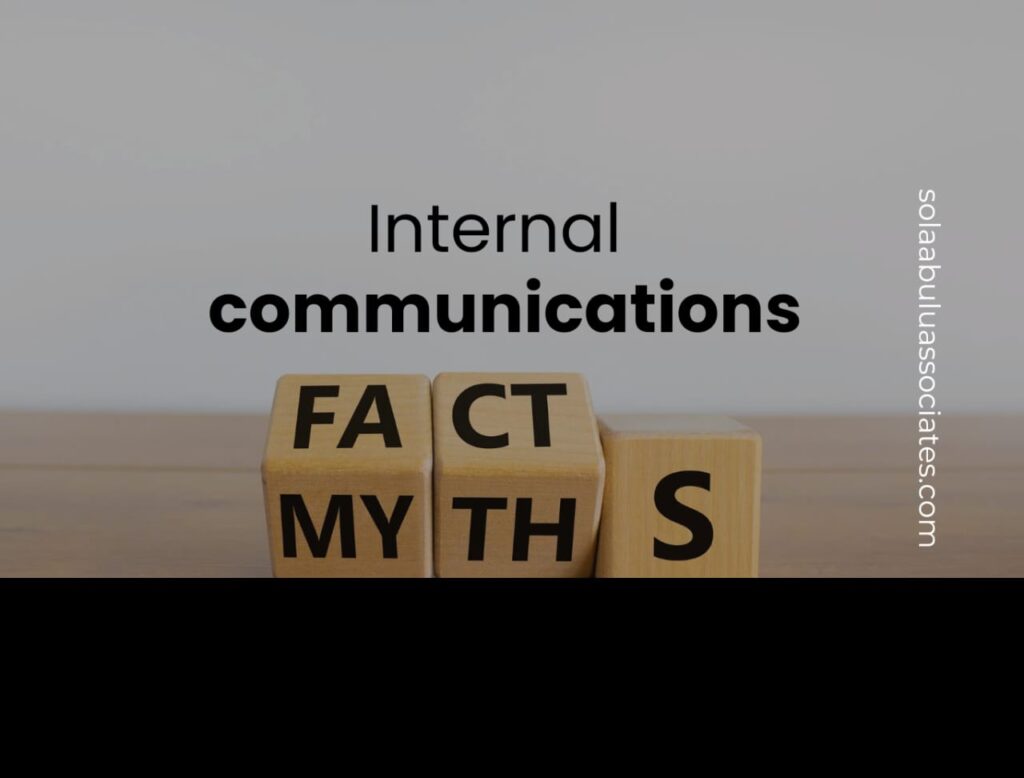Internal Communications Myths and Facts

To know what the existing myths and facts are in internal communications, it is important that we clearly define what the concept is and what it is not.
Sola Abulu opines that “transparent internal communication demonstrates the organization’s commitment to protecting its reputation and maintaining trust with its people.”
According to the Institute of Internal Communications (IoIC), “We believe the art and skill of internal communication is to effectively deliver information, knowledge and insights that build shared understanding. By aligning people with collective goals, internal communication underpins longer-term organisational sustainability.”
3 myths and facts about internal communications
- Myth: Internal Communications is a practice area for Human resource professionals in the organization.
Fact: In an article as far back as 2019, Forbes answered the question if internal communications belong to the human resources department or corporate communications team of an organization.
“…internal communications serve a broader role that extends external branding, including the organization’s mission, to an internal audience that encompasses not only employees but management and board members. In that sense, I’ve grown to see internal communications as its own discipline. It demands a precise skill-set, ranging careful and empathetic listening, clear and concise writing, oral and visual communications expertise, intellectual and emotional agility, and an almost journalistic sense of objectivity that enables telling a story straightforwardly with none-to-limited personal opinion.”
Internal communications should work closely with the human resource department alongside other departments within the organization but it is a stand-alone practice area in corporate communications.
- Myth: Anyone can practice internal communications
Fact: The expertise area demands more than just a flair for communications. Internal communications practitioners are trained in the art and science of communicating within corporate entities. It requires skills like writing, editing, content messaging, the ability to tell stories, knowledge of digital platforms, an ability to develop an internal communications strategy, plan and measure its success also.
- Myth: There is no organizational or business value of internal communications
Facts: Internal communications is not a pointless investment for organizations. This myth is one of the reasons why many business leaders and executive officers give the responsibility of internal communications to human resource officers whether trained in core communications or not because they believe that the practice area has no business value. However, the job of an internal communications professional can be measured if you set Specific, Measurable, Achievable, Realistic and Time-bound (SMART) goals. Therefore, the internal communications framework must be applied to fit into the communications strategy and tailored to the needs of the organization. Are you finding it difficult to develop an internal communications strategy? You will find this guide and template very useful.
To learn about other misconceptions about internal communications, read and explore this article by Sola Abulu.
………………….
This year, we launched our new learning portal with a pre-recorded professional strategic communications course available for communications leaders/ professionals, business owners/entrepreneurs and human resource managers/consultants. If this is you, you can sign up for the course here and have access to all the course provisions and benefits.
Sola Abulu & Associates is a strategy and communications training and consulting firm focused on enabling businesses, brands and institutions to achieve their desired objectives through strategic communications and reputation management.
